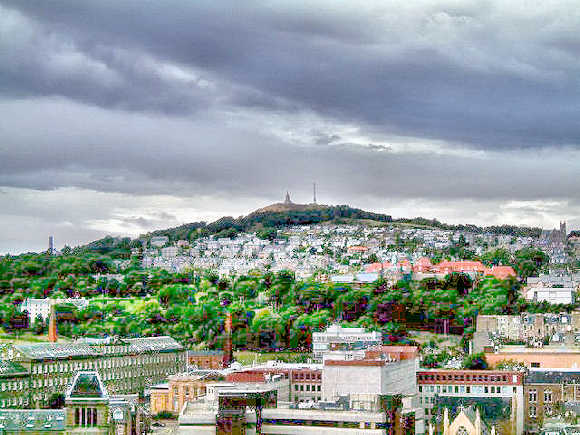 |
| The Dundee Law War Memorial Overlooking the City |
Dundee—one of the eight major cities of Scotland—was declining economically at the time of the Great War. Once the world capital of the jute industry, Dundee had become uncompetive against India. Nontheless, many of its 175,000 citizens were still employed in the textile and ship-building industries. In the midst of the July Crisis of 1914 the city was thrilled to receive a morale-boosting royal visit from King George V and his family. Soon afterward the city responded to the call to arms enthusiastically. Over 30,000 of its sons enlisted in the various forces and more than 4,213 would die in service.
 |
| 4th Battalion in the Trenches |
At the beginning of the First World War, many Dundonian men joined the 4th (City of Dundee) Battalion, the Black Watch. This local territorial infantry unit almost entirely consisted of men from the city and its immediate surrounding areas. The battalion came to be known as Dundee’s Own. They played a major role in the early battle of Neuve Chapelle and Loos. Losses were so great that the 4th Battalion was merged with the 5th Battalion of the Black Watch for the remainder of the war. During the Second World War Dundee again provided manpower for the Black Watch and a memorial to soldiers of the 4/5 Black Watch was dedicated to the fallen in 1959 atop the peak of Powrie Brae.
Dundee’s contribution to the First World War effort was widely recognised but it was also a leading center for the anti-war movement. At the time an anti-war newspaper, Forward, noted that Dundee "was fair hotchin’ wi conchies."
 |
| The Dundee Law Today |
At the end of the Great War, Dundee decided to honour the sacrifice of over 4,000 citizens by building the memorial on the Dundee Law, the hill that is the highest point in the city. The unveiling ceremony took place on 16 May 1925. Its simple inscription states: TO THE MEMORY OF DUNDEE MEN WHO FELL IN THE GREAT WAR 1914-1918.
There is a beacon at the top of the Law memorial which is lit on important dates to remember, such as 25 September, to commemorate the 1915 Battle of Loos, and 11 November, Armistice Day.
 |
| The 4th Battalion, the Black Watch, in the Attack, 1915 by Joseph Gray |
Joseph Lee, a 40-year-old journalist joined the 4th Black Watch, fought and survived the war, including a year as a prisoner of war, and became a respected war poet. From his "The Green Grass".
The dead spake together last night,
And one to the other said:
‘Why are we dead?’
They turned them face to face about
In the place where they were laid:
‘Why are we dead?’
‘This is the sweet, sweet month o’ May,
And the grass is green o’erhead –
Why are we dead?
‘The grass grows green on the long, long tracks
That I shall never tread –
Why are we dead?
‘The lamp shines like the glow-worm spark,
From the bield where I was bred –
Why am I dead?
The other spake: ‘I’ve wife and weans,
Yet I lie in this waesome bed –
Why am I dead?
Quoth the first: ‘I have a sweet, sweetheart,
And this night we should hae wed –
Why am I dead?
Sources: Dundee's Hidden Histories; Public Art Dundee, Great War Dundee; Discover War Poets

No comments:
Post a Comment